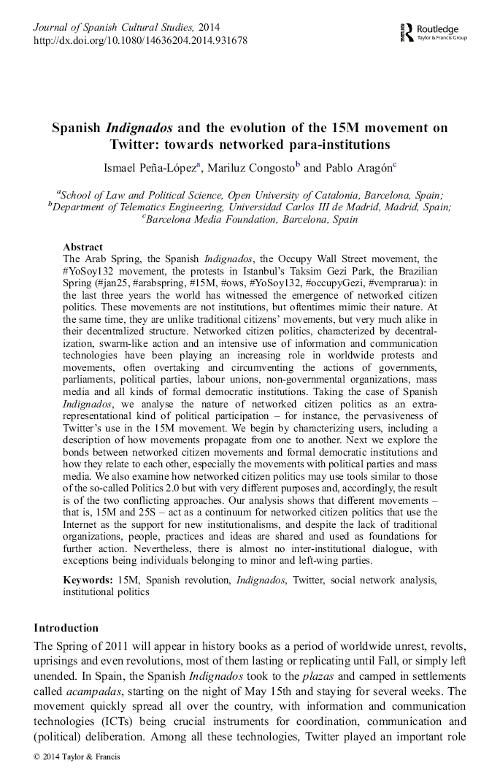
My colleagues Mariluz Congosto, Pablo Aragón and I just got a paper published. It is the final, improved version of a research that had already been presented thus:

Ismael Peña-López, lecturer and researcher
Information Society, Digital Divide, ICT4D

My colleagues Mariluz Congosto, Pablo Aragón and I just got a paper published. It is the final, improved version of a research that had already been presented thus:
Moderator: Rosa Borge. Lecturer, School of Law and Political Science (UOC).
This research has a different approach from the usual one: there is no theory that aims at being validated by data, but lots of data, an event, that is being analysed to see whether a theory or an explanation can be inferred.
Hacking + activism + netstrike = hacktivism. Technopolitics.
The crisis is a necessary but not sufficient condition for the movement to take place. The narrative and the previous experiences on the net, the evolution of memes (memethics) and campaigns, etc. are very important to set up the movements. In this sense, there is a “migration” of hashtags across several movements. On the other hand, most of the people that participated were already users of social networking sites. And not only social networking sites, but social movements in general: there is a powerful online-offline hybridization of participation.
Technopolitics is not cyberactivism, because it also happens outside of the net; and it is not slacktivism, because there is much more than just uncommitted online politics.
Multilayer approach: the physical layer, the media layer, the technological layer, etc.
Technopolitics is becoming a pattern, and an important one, all over the world’s politics.
Again, there is a high correlation between the online and the offline world, between Facebook groups and local (physical/offline) groups.
A technologically structured contagion took place during the indignados movement. How does this contagion happens? Emotions play a major role, are central in the movement.
Emotions, vocabulary, etc. are really synced during the movement, especially during offline events (and their replica online).
It is important to note the different organizational structures between parties — hierarchic, isolated — and the movement — decentralized, networked.
Central question in social science research: behaviour, communication, information dynamics. And methodological challenges: influence networks, actor attributes and roles, context and case studies.
What are the consequences of social media use on mobilization and diffusion? What are the bridges and commonalities between computer and social sciences?
The aim of the research is finding what is the state of the art of research in the field of mobilization and its relationship with social networking sites. A literature review for the period 2007-2013 was carried on.
Diffusion is based on the adoption of a practice or features through different channels. It depends on the message, the information dynamics, actors and the network structure. Some organizations play key roles in some mobilization processes, and specifically, the resources of these organizations. These resources can also be social capital, linkages and opportunities.
The relationship between actors, indeed, can tell us much about the probability that a movement can go on, can evolve, can grow.
Organizations are usually “sense makers”, they provide good explanations for what is happening in reality, they provide frames, scenarios, diagnosis, identify the main subjects. We know little, though, how the context changes, what are the group dynamics.
Concerning future research, we have to take into account the diffusion processes that involve information dynamics but also practices (tractics, strategies) and cultural norms. On the other hand, are we putting to much hope on Twitter or other social networking sites? We have also to analyze network linkages, formal structures vs. communication dynamics.
Live notes at the eResearch seminar by Tíscar Lara, Mariluz Congosto and José Luis Molina entitled Análisis de redes sociales: nuevas formas de visualización del conocimiento (Social network analysis: new forms of knowledge visualization). Citilab, Cornellà de Llobregat (Barcelona), Spain, June 17th, 2009.
See also e-research tag.
Blog analysis based on journalists that have a blog, as a middle ground between pro and personal. Of special interest how is the identity built: Identity building: domain name, about section, personal photography, affiliation, etc.
The network of blogs gets complicated with other Web 2.0 services. There’s a need to manage the increasing data with a model: Barriblog.
The model is based on two axes — content affinity and intensiveness of relationship — and measures links, conversations/comments and citations, adding them up in a relationship index.
Improvements on the model: time series, how have other web 2.0 applications (e.g. Twitter) impacted on blog usage and blog networking, etc.
How to visualize?
(see also: Gathering of visualization tools)
How can we map transnationality? Focusing on flows; focusing on active contacts with people with the same origin; focusing in the geographical distribution of all active contacts.
For instance, a visualization of Chinese immigration in the Barcelona metropolitan area shows that there’s more relationship with the country of origin (China) or the US, than within immigrants; that immigrants mainly settle in Barcelona and have poor relationship with Catalan rural areas; and that within Barcelona, they move around relatively few places. Visualization allows immediate glance to these facts while raw data does not.
Many ethical issues arise in an ether that covers all
, where everything we do is registered/tracked.
Use visualization to make better research questions, to get qualitative observations after quantitative data.
NOTE: difficult session where to take notes, as everything was so… visual.